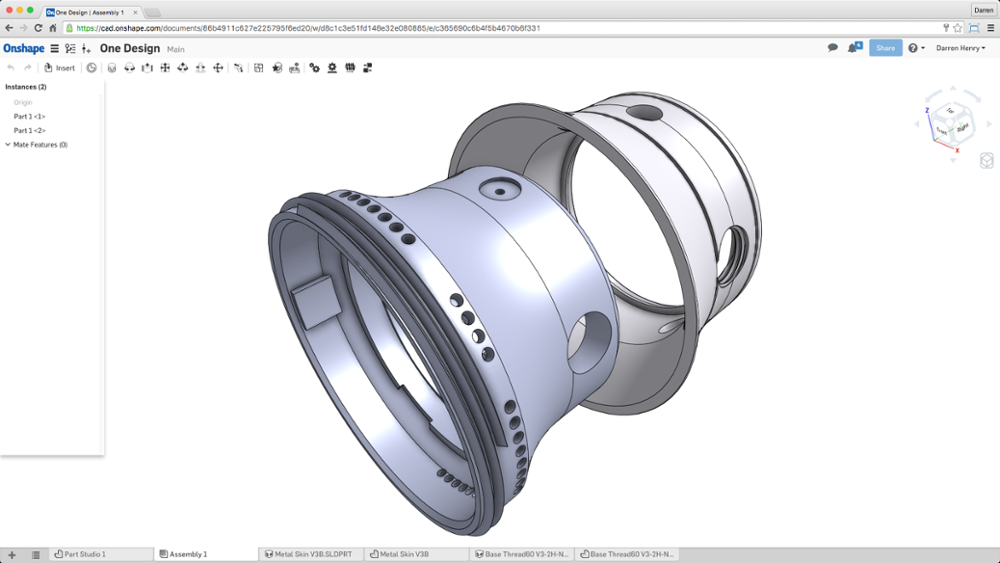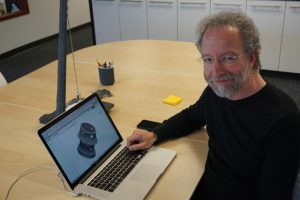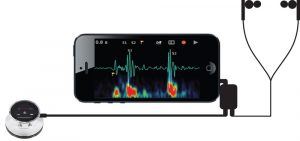
Thinklabs is now creating an improved stethoscope headphone design in Onshape that includes new features requested by doctors. CEO Clive Smith says Onshape enables “our production people to do production design. They can design the production processes and improve it themselves.” Image courtesy of Onshape/Thinklabs.
Latest News
April 1, 2017
On the 200th anniversary of the stethoscope, is the iconic medical instrument in danger of becoming obsolete? Or is it about to experience a technological renaissance?
In 1816, French physician Rene Laennec was embarrassed to press his ear to a young woman’s chest, the primary method of listening to a patient’s heartbeat at the time. As a more modest alternative, Dr. Laennec rolled up a stack of paper and placed one end of the cylinder to his ear and the other end on the patient’s body. Surprised by the clarity of sound, he later crafted a hollow wooden version with a brass tube insert. The stethoscope (named from the Greek words for “I see” and “the chest”) was born.
 Thinklabs founder Clive Smith has infused electronics and digital technologies into a medical device that stayed virtually unchanged for two centuries. Image courtesy of Thinklabs.
Thinklabs founder Clive Smith has infused electronics and digital technologies into a medical device that stayed virtually unchanged for two centuries. Image courtesy of Thinklabs.Although the materials have changed over the years, the general 19th century design has remained the same. And, respected voices in the medical community say the stethoscope now belongs in a museum, not the doctor’s office; they argue that handheld ultrasound devices provide more accurate diagnostic screenings.
However, not all medical experts agree that the stethoscope is ready for retirement. In a recent article for the New England Journal of Medicine, “Tenuous Tether,” cardiologist Elazer Edelman defends the traditional device as fundamental to the doctor-patient relationship.
“Laennec’s legacy lives on because it is not limited to a monaural tube, but includes the idea that we must in a sense become part of our patients, physically engaging them so that we can feel what they feel, sense how they suffer and fully comprehend what they are trying to tell us,” writes Edelman, the director of the Harvard-MIT Biomedical Engineering Center.
Also a professor at Harvard Medical School and a senior attending physician in the coronary care unit at Brigham and Women’s Hospital in Boston, he has been testing a new digital stethoscope called the Thinklabs One that can be connected to an external speaker and any computer, tablet or phone—turning the stethoscope from a “private hearing aid” to a “transcendent teaching tool.”
“Projected sounds also engage our patients, for they hear what we hear [often for the first time] and appreciate what we are doing [also often for the first time], which binds them to us and us to them,” Edelman writes. “One patient with severe mitral regurgitation commented: ‘No doctor has ever offered to let me listen. Now I can hear what makes me feel this way, and for that I thank you.’”
Thinklabs: The Next Generation of Stethoscope
The Thinklabs One Digital Stethoscope was developed by electrical engineer Clive Smith, who introduced an electromagnetic diaphragm (the large flat side of the chest piece) using a high-intensity electric field (almost 1 million volts per meter) to measure vibrations. Instead of the traditional hollow tube, the sound is transmitted through high quality headphones.
 Thinklabs is now creating an improved stethoscope headphone design in Onshape that includes new features requested by doctors. CEO Clive Smith says Onshape enables “our production people to do production design. They can design the production processes and improve it themselves.” Image courtesy of Onshape/Thinklabs.
Thinklabs is now creating an improved stethoscope headphone design in Onshape that includes new features requested by doctors. CEO Clive Smith says Onshape enables “our production people to do production design. They can design the production processes and improve it themselves.” Image courtesy of Onshape/Thinklabs.The innovative design recently made the Thinklabs One the stethoscope of choice for emergency physicians treating African victims of the Ebola virus. Wiring headphones into the protective medical suits was safer and more practical than the thick stethoscope tubes, which would have required cutting holes in the hoods, potentially exposing the ears and face to the virus.
“We decided to completely break the mold and do something very different and radical,” Smith says. “We’ve developed proprietary technology for producing extremely high-quality sound. The digital stethoscope has patented transducers and audio sensors that capture sounds from the body better than any other device.”
“You can barely hear anything when you use a regular stethoscope,” he adds. “The sound is very distant and faint. When you use our stethoscope, it’s significantly amplified. Instead of saying: ‘Can I hear that sound? What is that sound?,’ you’re more focused on what IS the sound. What’s the diagnosis? There’s no reason in this age of electronics and amplification why doctors should struggle to hear what’s going on.”
Edelman likens the audio improvement to the difference between AM radio and digital radio.
“It’s not that a seasoned clinician will make a diagnosis with the digital stethoscope that they couldn’t otherwise make,” he cautions. “It’s just that the ease of making the diagnosis, the confidence of the diagnosis and the difference between understanding the diagnosis over a graded scale, is now tremendously enhanced. And the ability to engage colleagues in making sure that they concur, and reinforcing your confidence in your diagnosis is made that much easier.”
Based in Colorado, Thinklabs was founded in 1991 in Smith’s garage. His initial research was funded by Agilent Technologies. The company’s digital stethoscopes are now being used by clinicians at medical institutions around the world, including Brigham and Women’s Hospital, the Mayo Clinic, NIH Clinical Center, Massachusetts General Hospital and Johns Hopkins University Hospital. Heart recordings using Thinklabs stethoscopes are widely used by medical schools, teaching hospitals, online medical journals and electronic medical textbooks.
Why Full-Cloud CAD “Liberates” Design and Production
From its conception to its commercial release, the development of the Thinklabs One has taken three years, following more than a decade of feedback from the Thinklabs user community. As Smith continues to challenge conventional thinking in the medical space, he’s also adopting new approaches to his design and manufacturing. All Thinklabs parts are made and assembled in house.
Although the company’s first digital scope was created with a traditional desktop-installed CAD system, Smith has since migrated to fully cloud-based CAD. His primary design tool for the next-generation Thinklabs stethoscope is now Onshape, the first browser-based professional 3D CAD system to run on any computer, tablet or phone.
“Our company is all cloud-based. We’re running Chromebooks and Netbooks and now any one of our production people can use Onshape while they are building our product,” he says. “Let’s say they are building something and they think: ‘You know, it would be really convenient if we had a jig that holds the frame that holds the product in a certain way.’ They can just hop on Onshape and design something and 3D print it. They can print a tool that they need for production.”
“3D printing liberates the design of our products. And Onshape in many ways liberates our production people to be very creative,” he adds. “We’re no longer tied to one computer. The old way was being forced to share what one of my engineering friends calls ‘the shrine.’”
“You go to the powerful computer with the copy of installed CAD software and you sit down and figure out who’s going to get a turn. We have a very open office plan. What happens now is that everyone can just pick any computer and say: ‘I’m going to design and 3D print this part and see if it makes our production more efficient,’” says Smith.
Smith says he manufactures parts with 3D printing rather than injection molding, allowing Thinklabs to rapidly deploy design changes as they happen. “When I discovered Onshape,” he says, “I was absolutely blown away you could have this kind of powerful CAD run inside a browser. I thought it was revolutionary.”
Saving Money on CAD Support, IT and Training
As an Onshape Professional Plan customer, Smith says he values the option to pay a monthly subscription for his CAD system instead of paying a lump sum for software upfront plus annual upgrade fees.
“We’re already established. We’re in production; we’re selling products. But if I take my mind back to when we were a startup, the last thing I’d want to do is throw $5,000 at a mechanical CAD package in order to get started,” he says. “It’s much better to pay $100 a month, spending three months doing some design and seeing if your idea has potential. It allows companies to try something new without making a big commitment. That’s huge for innovation.”
“As for our own savings, we were first attracted to Onshape because it’s cloud-based. That’s extremely valuable because we now don’t have a need for any IT support. We don’t need anyone maintaining versions, maintaining computers, backing up our computers. Everything is in the cloud,” Smith says.
 The Thinklabs One can be connected to an external speaker and any computer, tablet or phone—turning the stethoscope from a “private hearing aid” to a “transcendent teaching tool.” Image courtesy of Onshape/Thinklabs.
The Thinklabs One can be connected to an external speaker and any computer, tablet or phone—turning the stethoscope from a “private hearing aid” to a “transcendent teaching tool.” Image courtesy of Onshape/Thinklabs.With many of the Thinklabs assembly workers having CAD backgrounds (and expected to think like designers), Onshape’s online training videos and webinars make it easy for them to independently learn at their own pace.
“I’m an experienced CAD user and was astounded by how quickly I learned Onshape,” Smith says. “I watched about six videos, each two or three minutes long, and then I just practiced on a random drawing to see what I could do. Within a couple of hours, I could do what I needed to do.”
“The learning curve on mechanical CAD is historically horrendous,” he adds. “If I’m trying to hire somebody, I’m no longer locked into one program. I can bring in an aerospace engineer who’s got a huge amount of experience in SOLIDWORKS or Autodesk and I have absolutely no hesitation just throwing Onshape at them—knowing they’ll be up to speed in a matter of hours.”
What’s in Store for the Next 200 Years?
Whether as a teaching tool or as a diagnostic device, Smith predicts that the digital stethoscope will forge new roles for itself alongside established and emerging medical imaging technologies.
“Stethoscopes are still very important in remote health care. When you can now connect the stethoscope to mobile platforms and interconnect and interoperate with other things, it makes it a much more useful medical device,” he says. “Here on the 200th anniversary of its invention, there’s actually going to be a renaissance with new applications that people have not even imagined until now.”
And full-cloud design tools will be part of that renaissance.
“Onshape has become an integral part of our design-production loop,” Smith says. “Really, I’m not easily impressed. I’m a skeptic. I became impressed with Onshape by using it.”
For more information:
Subscribe to our FREE magazine, FREE email newsletters or both!
Latest News






